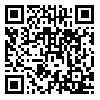دوره 8، شماره 4 - ( 8-1398 )
جلد 8 شماره 4 صفحات 195-194 |
برگشت به فهرست نسخه ها
Download citation:
BibTeX | RIS | EndNote | Medlars | ProCite | Reference Manager | RefWorks
Send citation to:



BibTeX | RIS | EndNote | Medlars | ProCite | Reference Manager | RefWorks
Send citation to:
Mirzaei S, Mohammadinia L. Importance of Developing a Local Instrument of Disaster-resilient School, Letter to Editor. JCHR 2019; 8 (4) :194-195
URL: http://jhr.ssu.ac.ir/article-1-532-fa.html
URL: http://jhr.ssu.ac.ir/article-1-532-fa.html
میرزائی سمانه، محمدی نیا لیلا. اهمیت طراحی ابزار بومی تاب اوری مدارس در حوادث و بلایا. مجله تحقیقات سلامت. 1398; 8 (4) :194-195
1- 1.گروه سلامت در بلایا ، دانشکده بهداشت ، دانشگاه علوم پزشکی شهید صدوقی ، یزد ، ایران
2- 2.گروه سلامت در بلایا ، مرکز تحقیقات مدیریت سلامت و منابع انسانی ، دانشکده مدیریت و اطلاع رسانی ، دانشگاه علوم پزشکی شیراز ، شیراز ، ایران ،leyla.mohammadinia@gmail.com
2- 2.گروه سلامت در بلایا ، مرکز تحقیقات مدیریت سلامت و منابع انسانی ، دانشکده مدیریت و اطلاع رسانی ، دانشگاه علوم پزشکی شیراز ، شیراز ، ایران ،
چکیده: (5385 مشاهده)
در دنیا رخداد انواع مخاطرات و به دنبال آن آسیب های مالی و جانی توجه به موضوع آموزش برای ارتقاء آمادگی رادر اسناد بالادستی دو چندان کرده است. اهمیت آموزش بلایا دربرنامه عملیاتی هیوگو 2005-2015(1) و چارچوب Sendai 2015-2030(2) با رویکرد کاهش خطر بلایا، ایجاد تاب آوری در راستای توسعه پایدار مکرراً تاکید شده است. در این میان مدارس نقش مهمی در اموزش نسل ها به عهده دارند که می تواند با گذر زمان در افزایش تاب اوری و کاهش خطر بلایا نقش موثری داشته باشد(3). مدارس به عنوان مکان آموزشی هر ساله میزبان تعداد بیشماری از دانش آموزانی هستند که بیشتر زمان روزانه خود را در آن محیط سپری میکنند. مدارس علاوه بر نقش مکان آموزشی به عنوان یک ظرفیت جامعه برای محل تجمع و اسکان اضطراری در زمان رخداد حوادث و بلایا نیز در نظر گرفته می شود(4). این درحالی است که در برخی موارد به علت آسیب سازه و عدم تاب آوری سازه ای هنگام رخداد حوادث و بلایا بدین منظور کارا نمی باشد. از سویی دیگر هر ساله تعداد زیادی از دانش آموزان مدارس به دنبال رخداد مخاطرات طبیعی و انسان ساخت دچار آسیب و حتی مرگ می شوند.مثلا زلزله و سونامی ژاپن (2011) منجر به آسیب 6000 مدرسه و مرگ 607 نفر ( 575 دانش آموز و 24 معلم) شد(5). زلزله bohol فیلیپین(2013)نیز منجر به آسیب 604 مدرسه ابتدایی و 92 دبیرستان گردید(6). این ها نمونه ای از آسیب های مدارس است و این در حالی است که با اجرا و نظارت بر استانداردهای سازه ای ، زیرساخت ها، تدوین فرایند عملکردی در مدارس همراه با افزایش حساسیت و دقت می توان ایمن سازی، سطح آمادگی و تاب آوری مدارس را ارتقاء داد (7) تا محیطی امن و مطمئن نه تنها برای آموزش دانش آموزان در هنگام رخداد حوادث و بلایا باشد بلکه اسکانی مناسب برای بازماندگان بلایا نیز باشد. همچنین باید توجه داشت که مدارس تاب آور میتوانند با ایجاد برنامه های آموزشی در حوزه درک خطر و اقدامات پیشگیرانه سطح آمادگی جامعه را برای پاسخ مناسب در شرایط حوادث و بلایا بهبود بخشند(8). داشتن ابزار مناسب برای سنجش سطح تاب آوری از مباحث چالش برانگیز است که موضوع دغدغه پژوهشگران حوزه حوادث و بلایا می باشد.
لذا ضروری است ابزار بومی مناسب جهت سنجش و بررسی مولفه های موثر بر تاب اوری مدارس تهیه و در دسترس متولیان از جمله سازمان آموزش و پرورش قرار گیرد.
لذا ضروری است ابزار بومی مناسب جهت سنجش و بررسی مولفه های موثر بر تاب اوری مدارس تهیه و در دسترس متولیان از جمله سازمان آموزش و پرورش قرار گیرد.
فهرست منابع
1. ISDR U, editor Hyogo framework for action 2005-2015: building the resilience of nations and communities to disasters. Extract from the final report of the World Conference on Disaster Reduction (A/CONF 206/6); 2005: The United Nations International Strategy for Disaster Reduction Geneva.available from: https://www.unisdr.org/2005/ wcdr/intergover/official-doc/L-docs/Hyogo-framework-for-action-english.pdf
2. Maini R, Clarke L, Murray V. Disasters, health impacts and the value of implementing the Sendai Framework for Disaster Risk Reduction 2015-2030. The Routledge Handbook of Green Social Work: Routledge; 2018. p. 35-47. [DOI:10.4324/9781315183213-4]
3. Oktari RS, Shiwaku K, Munadi K, Syamsidik, Shaw R. Enhancing community resilience towards disaster: The contributing factors of school-community collaborative network in the tsunami affected area in Aceh. International Journal of Disaster Risk Reduction. 2018;29:3-12. [DOI:10.1016/j.ijdrr.2017.07.009]
4. Anelli A, Santa-Cruz S, Vona M, et al. A proactive and resilient seismic risk mitigation strategy for existing school buildings. Structure and Infrastructure Engineering. 2019;15(2):137-51. [DOI:10.1080/15732479.2018.1527373]
5. Kurokawa N. The experience of large earthquakes in Japan and impact on body physique in schoolchildren. The Journal of Physical Fitness and Sports Medicine. 2018;7(1):15-8. [DOI:10.7600/jpfsm.7.15]
6. Ilumin RC, Oreta AWC. A Post-Disaster Functional Asset Value Index for School Buildings. Procedia engineering. 2018;212:230-7. [DOI:10.1016/j.proeng.2018.01.030]
7. Bhaeia S, : Kheradmand M. Safe Schools for the Community: A Case and Tool for Disaster-Proof Schools. Journal of Tehran Disaster Management and Mitigation Organization (TDMMO). 2015;5(1):69-79.from available: https://www.civilica.com/Paper-JR_DPMK-JR_DPMK-5-1_006.html
8. UNICEF. Towards a learning culture of safety and resilience: Technical guidance for integrating disaster risk reduction in the school curriculum: UNESCO; 2014.
ارسال پیام به نویسنده مسئول
| بازنشر اطلاعات | |
 |
این مقاله تحت شرایط Creative Commons Attribution 4.0 International License قابل بازنشر است. |






